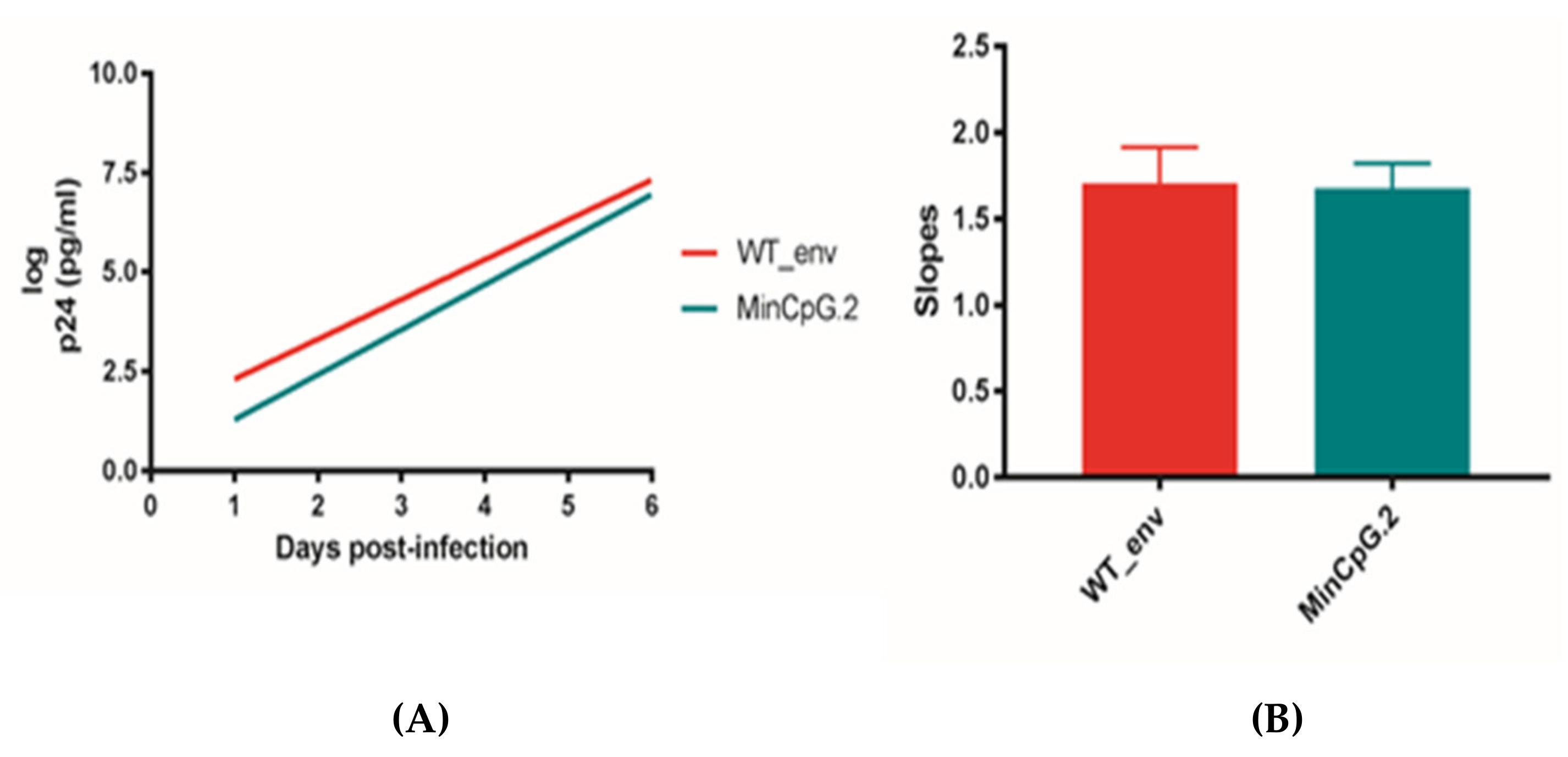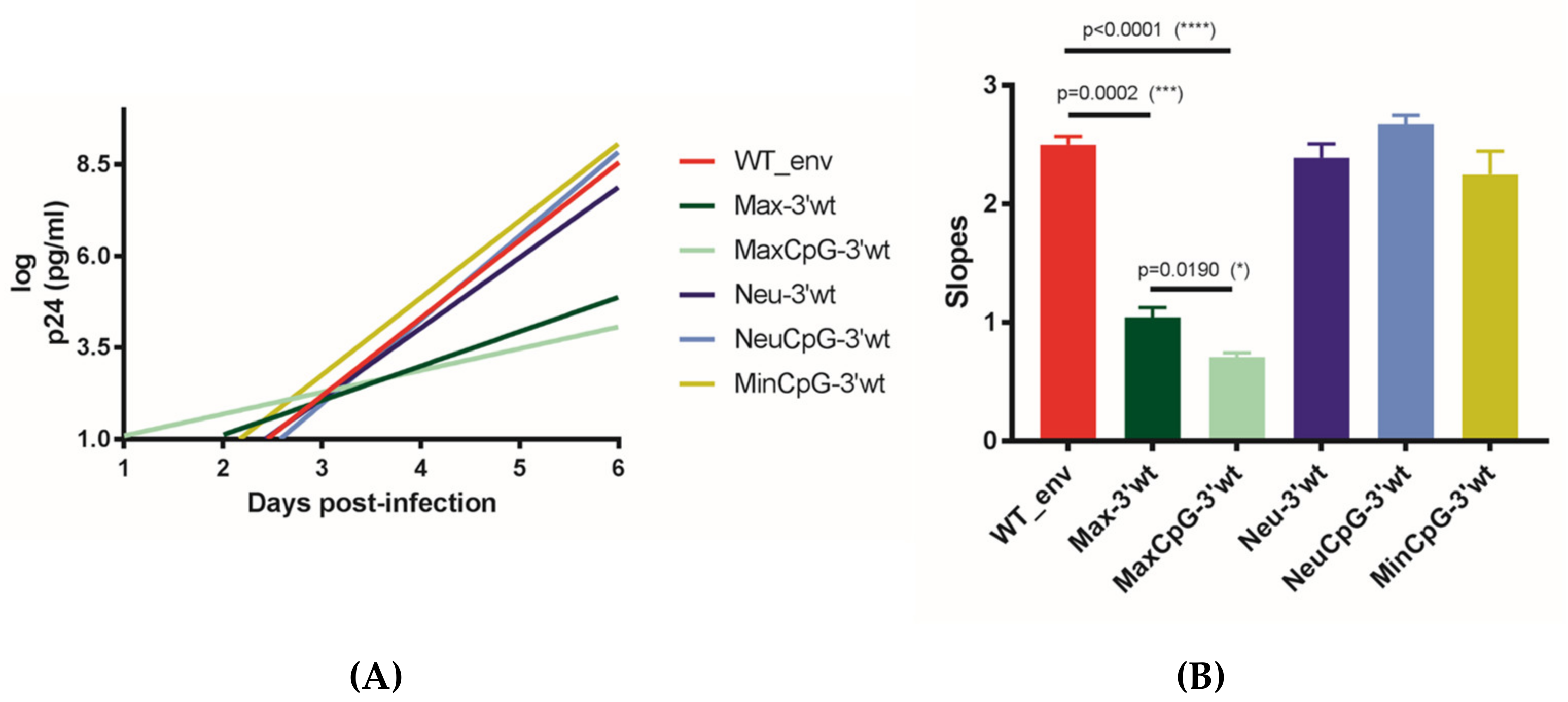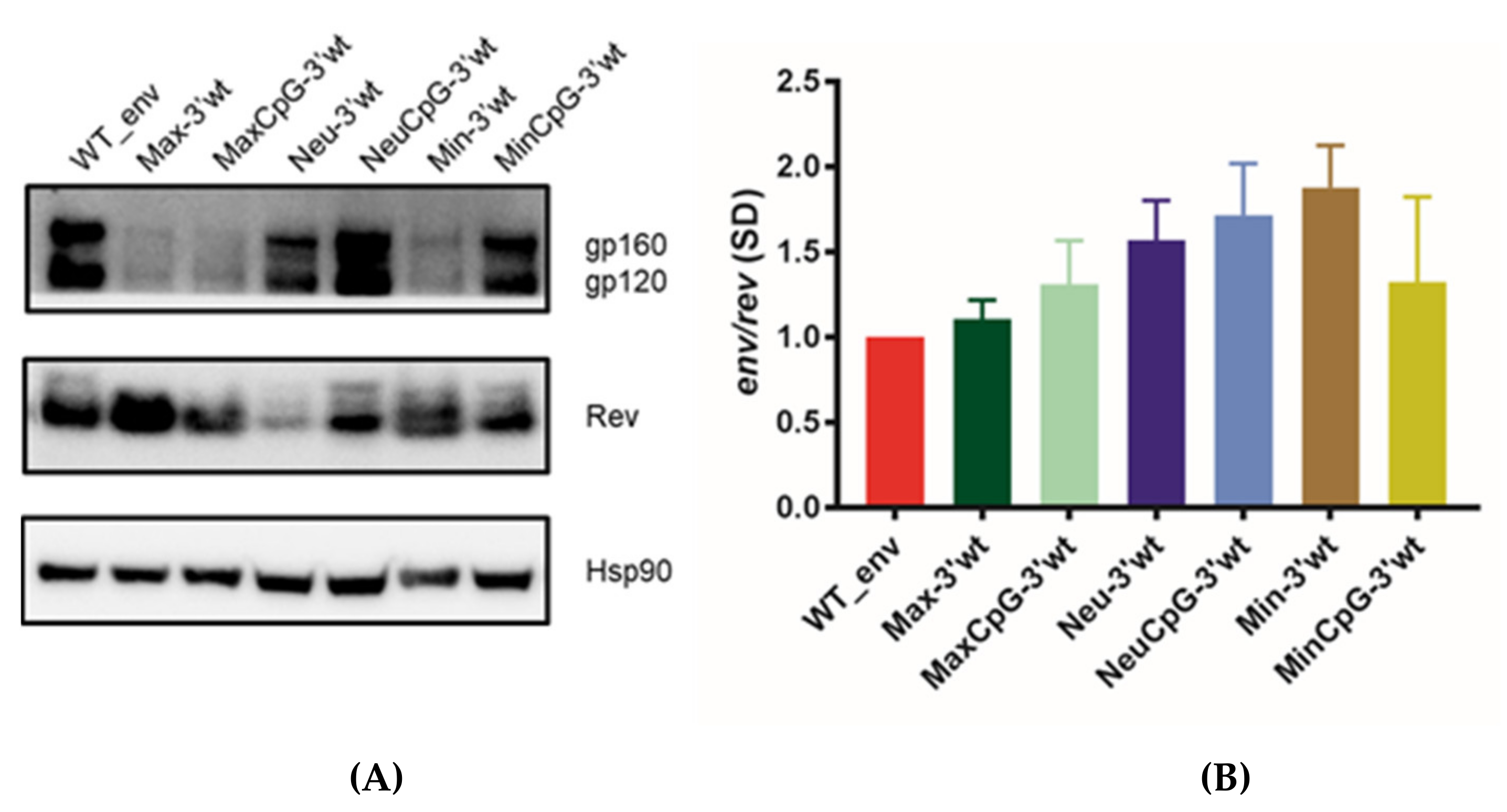Synonymous Codon Pair Recoding of the HIV-1 env Gene Affects Virus Replication Capacity
Abstract
:1. Introduction
2. Materials and Methods
2.1. Cell Lines
2.2. Generation of Synthetic Infectious HIV-1 Env Variants
2.3. Replication Capacity Assays
2.4. Plasmids and HIV-1 Env Expression
2.5. Immunoblot Analyses and Antibodies
2.6. Real-Time Quantitative PCR
2.7. Statistical Analysis
3. Results
4. Discussion
Supplementary Materials
Author Contributions
Funding
Institutional Review Board Statement
Informed Consent Statement
Data Availability Statement
Acknowledgments
Conflicts of Interest
References
- Martínez, M.A.; Jordan-Paiz, A.; Franco, S.; Nevot, M. Synonymous genome recoding: A tool to explore microbial biology and new therapeutic strategies. Nucleic Acids Res. 2019, 47, 10506–10519. [Google Scholar] [CrossRef] [PubMed]
- Martínez, M.A.; Jordan-Paiz, A.; Franco, S.; Nevot, M. Synonymous Virus Genome Recoding as a Tool to Impact Viral Fitness. Trends Microbiol. 2016, 24, 134–147. [Google Scholar] [CrossRef] [PubMed]
- Ficarelli, M.; Wilson, H.; Galão, R.P.; Mazzon, M.; Antzin-Anduetza, I.; Marsh, M.; Neil, S.J.D.; Swanson, C.M. KHNYN is essential for the zinc finger antiviral protein (ZAP) to restrict HIV-1 containing clustered CpG dinucleotides. eLife 2019, 8. [Google Scholar] [CrossRef] [PubMed]
- Takata, M.; Soll, S.J.; Emery, A.; Blanco-Melo, D.; Swanstrom, R.; Bieniasz, P.D. Global synonymous mutagenesis identifies cis-acting RNA elements that regulate HIV-1 splicing and replication. PLoS Pathog. 2018, 14. [Google Scholar] [CrossRef] [Green Version]
- Ficarelli, M.; Antzin-Anduetza, I.; Hugh-White, R.; Firth, A.E.; Sertkaya, H.; Wilson, H.; Neil, S.J.D.; Schulz, R.; Swanson, C.M. CpG Dinucleotides Inhibit HIV-1 Replication through Zinc Finger Antiviral Protein (ZAP)-Dependent and -Independent Mechanisms. J. Virol. 2019, 94. [Google Scholar] [CrossRef] [Green Version]
- Jordan-Paiz, A.; Franco, S.; Martínez, M.A. Impact of Synonymous Genome Recoding on the HIV Life Cycle. Front. Microbiol. 2021, 12, 606087. [Google Scholar] [CrossRef]
- Kmiec, D.; Nchioua, R.; Sherrill-Mix, S.; Stürzel, C.M.; Heusinger, E.; Braun, E.; Gondim, M.V.P.; Hotter, D.; Sparrer, K.M.J.; Hahn, B.H.; et al. CpG frequency in the 5’ third of the env gene determines sensitivity of primary HIV-1 strains to the zinc-finger antiviral protein. MBio 2020, 11. [Google Scholar] [CrossRef] [Green Version]
- Jordan-Paiz, A.; Nevot, M.; Lamkiewicz, K.; Lataretu, M.; Franco, S.; Marz, M.; Martinez, M.A. HIV-1 Lethality and Loss of Env Protein Expression Induced by Single Synonymous Substitutions in the Virus Genome Intronic-Splicing Silencer. J. Virol. 2020, 94. [Google Scholar] [CrossRef] [PubMed]
- Nevot, M.; Jordan-Paiz, A.; Martrus, G.; Andrés, C.; García-Cehic, D.; Gregori, J.; Franco, S.; Quer, J.; Martinez, M.A. HIV-1 Protease Evolvability Is Affected by Synonymous Nucleotide Recoding. J. Virol. 2018, 92. [Google Scholar] [CrossRef] [Green Version]
- Martrus, G.; Nevot, M.; Andres, C.; Clotet, B.; Martinez, M.A. Changes in codon-pair bias of human immunodeficiency virus type 1 have profound effects on virus replication in cell culture. Retrovirology 2013, 10. [Google Scholar] [CrossRef] [Green Version]
- Takata, M.A.; Gonçalves-Carneiro, D.; Zang, T.M.; Soll, S.J.; York, A.; Blanco-Melo, D.; Bieniasz, P.D. CG dinucleotide suppression enables antiviral defence targeting non-self RNA. Nature 2017, 550, 124–127. [Google Scholar] [CrossRef] [PubMed]
- Li, M.; Kao, E.; Gao, X.; Sandig, H.; Limmer, K.; Pavon-Eternod, M.; Jones, T.E.; Landry, S.; Pan, T.; Weitzman, M.D.; et al. Codon-usage-based inhibition of HIV protein synthesis by human schlafen 11. Nature 2012, 491, 125–128. [Google Scholar] [CrossRef] [Green Version]
- Gutman, G.A.; Hatfield, G.W. Nonrandom utilization of codon pairs in Escherichia coli. Proc. Natl. Acad. Sci. USA 1989, 86, 3699–3703. [Google Scholar] [CrossRef] [Green Version]
- Coleman, J.R.; Papamichail, D.; Skiena, S.; Futcher, B.; Wimmer, E.; Mueller, S. Virus attenuation by genome-scale changes in codon pair bias. Science 2008, 320, 1784–1787. [Google Scholar] [CrossRef] [PubMed] [Green Version]
- Mueller, S.; Coleman, J.R.; Papamichail, D.; Ward, C.B.; Nimnual, A.; Futcher, B.; Skiena, S.; Wimmer, E. Live attenuated influenza virus vaccines by computer-aided rational design. Nat. Biotechnol. 2010, 28, 723–726. [Google Scholar] [CrossRef] [PubMed] [Green Version]
- Le Nouën, C.; Brock, L.G.; Luongo, C.; McCarty, T.; Yang, L.; Mehedi, M.; Wimmer, E.; Mueller, S.; Collins, P.L.; Buchholz, U.J.; et al. Attenuation of human respiratory syncytial virus by genome-scale codon-pair deoptimization. Proc. Natl. Acad. Sci. USA 2014, 111, 13169–13174. [Google Scholar] [CrossRef] [Green Version]
- Shen, S.H.; Stauft, C.B.; Gorbatsevych, O.; Song, Y.; Ward, C.B.; Yurovsky, A.; Mueller, S.; Futcher, B.; Wimmer, E. Large-scale recoding of an arbovirus genome to rebalance its insect versus mammalian preference. Proc. Natl. Acad. Sci. USA 2015, 112, 4749–4754. [Google Scholar] [CrossRef] [PubMed] [Green Version]
- Tulloch, F.; Atkinson, N.J.; Evans, D.J.; Ryan, M.D.; Simmonds, P. RNA virus attenuation by codon pair deoptimisation is an artefact of increases in CpG/UpA dinucleotide frequencies. eLife 2014, 3, e04531. [Google Scholar] [CrossRef] [Green Version]
- Kunec, D.; Osterrieder, N. Codon Pair Bias Is a Direct Consequence of Dinucleotide Bias. Cell Rep. 2016, 14, 55–67. [Google Scholar] [CrossRef] [PubMed] [Green Version]
- Fujita, Y.; Otsuki, H.; Watanabe, Y.; Yasui, M.; Kobayashi, T.; Miura, T.; Igarashi, T. Generation of a replication-competent chimeric simian-human immunodeficiency virus carrying env from subtype C clinical isolate through intracellular homologous recombination. Virology 2013, 436, 100–111. [Google Scholar] [CrossRef] [PubMed] [Green Version]
- Lu, X.; Heimer, J.; Rekosh, D.; Hammarskjold, M.L. U1 small nuclear RNA plays a direct role in the formation of a rev-regulated human immunodeficiency virus env mRNA that remains unspliced. Proc. Natl. Acad. Sci. USA 1990, 87, 7598–7602. [Google Scholar] [CrossRef] [PubMed] [Green Version]
- Groenke, N.; Trimpert, J.; Merz, S.; Conradie, A.M.; Wyler, E.; Zhang, H.; Hazapis, O.G.; Rausch, S.; Landthaler, M.; Osterrieder, N.; et al. Mechanism of Virus Attenuation by Codon Pair Deoptimization. Cell Rep. 2020, 31. [Google Scholar] [CrossRef] [PubMed]
- Le Nouën, C.; Luongo, C.L.; Yang, L.; Mueller, S.; Wimmer, E.; DiNapoli, J.M.; Collins, P.L.; Buchholz, U.J. Optimization of the Codon Pair Usage of Human Respiratory Syncytial Virus Paradoxically Resulted in Reduced Viral Replication In Vivo and Reduced Immunogenicity. J. Virol. 2019, 94. [Google Scholar] [CrossRef] [PubMed] [Green Version]
- Kypr, J.; Mrázek, J. Unusual codon usage of HIV. Nature 1987, 327, 20. [Google Scholar] [CrossRef]
- Li, M.M.H.; Lau, Z.; Cheung, P.; Aguilar, E.G.; Schneider, W.M.; Bozzacco, L.; Molina, H.; Buehler, E.; Takaoka, A.; Rice, C.M.; et al. TRIM25 Enhances the Antiviral Action of Zinc-Finger Antiviral Protein (ZAP). PLoS Pathog. 2017, 13. [Google Scholar] [CrossRef]
- Zheng, X.; Wang, X.; Tu, F.; Wang, Q.; Fan, Z.; Gao, G. TRIM25 Is Required for the Antiviral Activity of Zinc Finger Antiviral Protein. J. Virol. 2017, 91. [Google Scholar] [CrossRef] [Green Version]
- Steckbeck, J.D.; Craigo, J.K.; Barnes, C.O.; Montelaro, R.C. Highly conserved structural properties of the C-terminal tail of HIV-1 gp41 protein despite substantial sequence variation among diverse clades: Implications for functions in viral replication. J. Biol. Chem. 2011, 286, 27156–27166. [Google Scholar] [CrossRef] [Green Version]
- Ashkenazi, A.; Faingold, O.; Kaushansky, N.; Ben-Nun, A.; Shai, Y. A highly conserved sequence associated with the HIV gp41 loop region is an immunomodulator of antigen-specific T cells in mice. Blood 2013, 121, 2244–2252. [Google Scholar] [CrossRef] [Green Version]



| Env | No. of Mutations | CpGs | UpAs | CPS | CAI |
|---|---|---|---|---|---|
| WT | - | 26 | 194 | 0.046 | 0.137 |
| Max | 361 | 43 | 152 | 0.176 | 0.158 |
| Neu | 396 | 50 | 156 | 0.035 | 0.183 |
| Min | 427 | 111 | 144 | −0.160 | 0.213 |
| MaxCpG | 348 | 21 | 155 | 0.160 | 0.156 |
| NeuCpG | 380 | 29 | 159 | 0.041 | 0.180 |
| MinCpG | 374 | 24 | 151 | −0.085 | 0.189 |
| MinCpG.2 | 354 | 23 | 158 | −0.086 | 0.191 |
| Max-3′WT | 294 | 39 | 161 | 0.147 | 0.153 |
| MaxCpG-3′WT | 284 | 24 | 163 | 0.134 | 0.152 |
| Neu-3′WT | 319 | 47 | 164 | 0.030 | 0.173 |
| NeuCpG-3′WT | 305 | 30 | 166 | 0.035 | 0.170 |
| Min-3′WT | 350 | 103 | 156 | −0.129 | 0.194 |
| MinCpG-3′WT | 297 | 26 | 163 | −0.059 | 0.171 |
| Env | No. of CpGs | No. of UpAs |
|---|---|---|
| WT | 8 | 128 |
| Max-3′WT | 21 | 95 |
| MaxCpG-3′WT | 6 | 97 |
| Neu-3′WT | 29 | 98 |
| NeuCpG-3′WT | 12 | 100 |
| Min-3′WT | 85 | 90 |
| MinCpG-3′WT | 8 | 97 |
Publisher’s Note: MDPI stays neutral with regard to jurisdictional claims in published maps and institutional affiliations. |
© 2021 by the authors. Licensee MDPI, Basel, Switzerland. This article is an open access article distributed under the terms and conditions of the Creative Commons Attribution (CC BY) license (https://creativecommons.org/licenses/by/4.0/).
Share and Cite
Jordan-Paiz, A.; Franco, S.; Martinez, M.A. Synonymous Codon Pair Recoding of the HIV-1 env Gene Affects Virus Replication Capacity. Cells 2021, 10, 1636. https://doi.org/10.3390/cells10071636
Jordan-Paiz A, Franco S, Martinez MA. Synonymous Codon Pair Recoding of the HIV-1 env Gene Affects Virus Replication Capacity. Cells. 2021; 10(7):1636. https://doi.org/10.3390/cells10071636
Chicago/Turabian StyleJordan-Paiz, Ana, Sandra Franco, and Miguel Angel Martinez. 2021. "Synonymous Codon Pair Recoding of the HIV-1 env Gene Affects Virus Replication Capacity" Cells 10, no. 7: 1636. https://doi.org/10.3390/cells10071636
APA StyleJordan-Paiz, A., Franco, S., & Martinez, M. A. (2021). Synonymous Codon Pair Recoding of the HIV-1 env Gene Affects Virus Replication Capacity. Cells, 10(7), 1636. https://doi.org/10.3390/cells10071636







